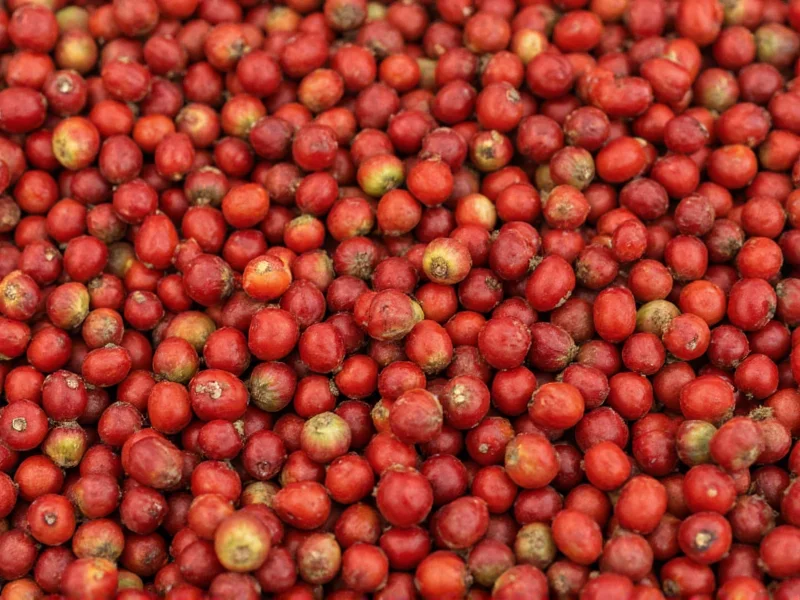When exploring the world of premium spices, understanding big peppercorns reveals important culinary distinctions that impact flavor development in dishes. Many home cooks and professional chefs seek out these larger berries for specific applications where standard black pepper falls short.
What Makes Peppercorns "Big"?
The term "big peppercorns" isn't a botanical classification but rather a market designation for premium-grade peppercorns that meet specific size criteria. The most common type falling into this category are Tellicherry peppercorns, named after the Kerala region in India where they're predominantly grown.
Peppercorn size directly correlates with harvest timing:
| Peppercorn Grade | Size Range | Harvest Timing | Flavor Profile |
|---|---|---|---|
| Tellicherry Extra Bold | 4.25mm and above | Late harvest (35+ days) | Complex, fruity, less sharp |
| Tellicherry Bold | 4.0-4.25mm | Late harvest | Balanced heat and aroma |
| Malabar Special | 3.5-4.0mm | Standard harvest | Classic pepper heat |
| Regular Grade | Below 3.5mm | Early harvest | Sharper, less nuanced |
Culinary Advantages of Large Peppercorns
Chefs prefer large tellicherry peppercorns uses for several preparation methods where size matters. The increased surface area-to-volume ratio in bigger peppercorns creates distinct advantages:
- Whole peppercorn applications: Larger berries hold up better in pickling brines, stocks, and marinades without dissolving completely
- Coarse grinding: When using a pepper mill set to coarse, big peppercorns produce more substantial flakes that distribute evenly in dishes
- Flavor development: The extended ripening period develops more nuanced flavor compounds beyond just piperine (the compound responsible for heat)
- Aromatic complexity: Mature berries contain higher concentrations of essential oils that release gradually during cooking
Difference Between Regular and Big Peppercorns
Understanding the difference between regular and big peppercorns goes beyond mere physical dimensions. The maturation process fundamentally changes the chemical composition:
Standard black peppercorns are harvested when berries begin turning red but before full maturity. This early harvest yields smaller berries with higher piperine concentration (creating sharper heat) but fewer aromatic compounds. In contrast, Tellicherry-grade peppercorns remain on the vine until nearly ripe, developing more complex flavor precursors while slightly reducing the harsh piperine content.
When conducting side-by-side tastings of tellicherry vs regular black peppercorns, professional tasters consistently note:
- Big peppercorns deliver initial fruity notes before the heat develops
- Longer finish with earthy, woody undertones
- Less aggressive heat that integrates better with other ingredients
- More pronounced floral aromatics when freshly cracked
Practical Cooking Applications
Knowing how to use oversized peppercorns properly maximizes their culinary potential. These larger berries excel in specific applications where standard pepper would be less effective:
Dry Rubs and Marinades
When creating dry rubs for meats, big peppercorns provide visible texture and controlled heat release. Their size prevents them from becoming powdery when mixed with other spices. For best results, coarsely crack Tellicherry peppercorns rather than grinding them finely.
Pickling and Brines
Whole big peppercorns maintain their integrity during extended soaking in vinegar-based solutions. Their size prevents them from becoming mushy or over-extracting, which can happen with smaller peppercorns. Use 1-2 teaspoons of whole Tellicherry peppercorns per quart of pickling liquid.
Sauces and Reductions
When making pan sauces or reductions, add whole big peppercorns early in the cooking process. Their size allows for easy removal before serving while still infusing the liquid with complex flavors. This technique works particularly well for cream sauces and wine reductions.
Storage Considerations for Premium Peppercorns
Proper storage preserves the volatile oils that give premium large peppercorns their distinctive flavor. Unlike pre-ground pepper, whole big peppercorns maintain freshness significantly longer when stored correctly:
- Keep in airtight containers away from light and heat sources
- Whole peppercorns retain peak flavor for 2-3 years versus 6-12 months for pre-ground
- Freezing is unnecessary and may cause moisture condensation
- Buy in smaller quantities (enough for 6 months) for optimal freshness
When evaluating peppercorn quality, look for uniform dark color without excessive dust or broken pieces. High-grade Tellicherry peppercorns should feel dense and heavy for their size, indicating proper drying and maturity.
Common Misconceptions About Big Peppercorns
Several myths persist about oversized peppercorns characteristics that deserve clarification:
- Myth: Big peppercorns are a different species than regular black pepper
Fact: All black peppercorns come from Piper nigrum; size reflects harvest timing - Myth: Larger peppercorns are always hotter
Fact: Mature berries often have slightly less intense heat but more complex flavor - Myth: "Tellicherry" refers to organic growing methods
Fact: It's a size/grade designation, not a farming practice indicator
Understanding these distinctions helps cooks make informed choices when selecting peppercorns for specific culinary applications. The premium price of Tellicherry-grade peppercorns reflects the additional labor required for selective harvesting of fully mature berries rather than superior growing conditions.











 浙公网安备
33010002000092号
浙公网安备
33010002000092号 浙B2-20120091-4
浙B2-20120091-4